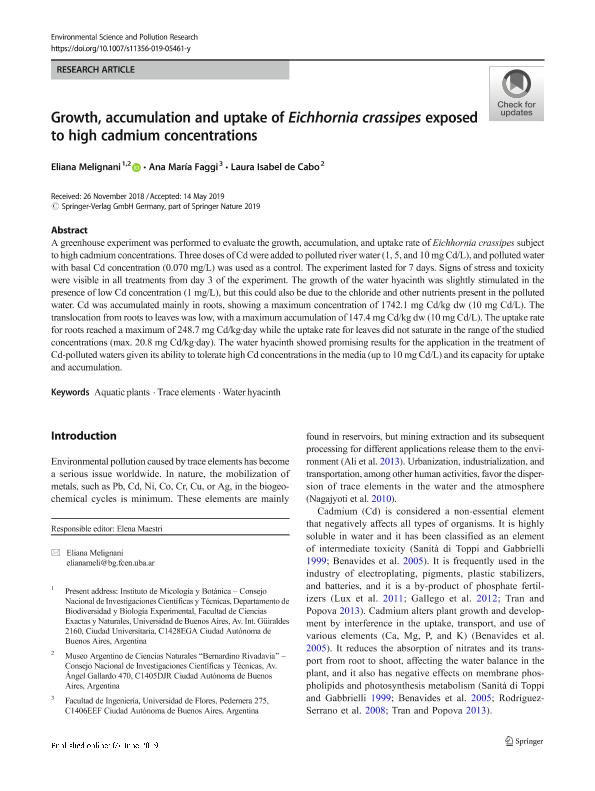Artículo
Growth, accumulation and uptake of Eichhornia crassipes exposed to high cadmium concentrations
Fecha de publicación:
06/2019
Editorial:
Springer Heidelberg
Revista:
Environmental Science and Pollution Research
ISSN:
0944-1344
e-ISSN:
1614-7499
Idioma:
Inglés
Tipo de recurso:
Artículo publicado
Clasificación temática:
Resumen
A greenhouse experiment was performed to evaluate the growth, accumulation, and uptake rate of Eichhornia crassipes subjectto high cadmiumconcentrations. Three doses of Cd were added to polluted river water (1, 5, and 10 mg Cd/L), and polluted waterwith basal Cd concentration (0.070 mg/L) was used as a control. The experiment lasted for 7 days. Signs of stress and toxicitywere visible in all treatments from day 3 of the experiment. The growth of the water hyacinth was slightly stimulated in thepresence of low Cd concentration (1 mg/L), but this could also be due to the chloride and other nutrients present in the pollutedwater. Cd was accumulated mainly in roots, showing a maximum concentration of 1742.1 mg Cd/kg dw (10 mg Cd/L). Thetranslocation from roots to leaves was low, with a maximum accumulation of 147.4 mg Cd/kg dw (10 mg Cd/L). The uptake ratefor roots reached a maximum of 248.7 mg Cd/kg·day while the uptake rate for leaves did not saturate in the range of the studiedconcentrations (max. 20.8 mg Cd/kg·day). The water hyacinth showed promising results for the application in the treatment ofCd-polluted waters given its ability to tolerate high Cd concentrations in the media (up to 10 mg Cd/L) and its capacity for uptakeand accumulation.
Palabras clave:
Aquatic plants
,
Trace elements
,
Water hyacinth
Archivos asociados
Licencia
Identificadores
Colecciones
Articulos(INMIBO (EX - PROPLAME))
Articulos de INSTITUTO DE MICOLOGIA Y BOTANICA
Articulos de INSTITUTO DE MICOLOGIA Y BOTANICA
Articulos(MACNBR)
Articulos de MUSEO ARG.DE CS.NAT "BERNARDINO RIVADAVIA"
Articulos de MUSEO ARG.DE CS.NAT "BERNARDINO RIVADAVIA"
Citación
Melignani, Eliana; Faggi, Ana Maria; de Cabo, Laura Isabel; Growth, accumulation and uptake of Eichhornia crassipes exposed to high cadmium concentrations; Springer Heidelberg; Environmental Science and Pollution Research; 26; 22; 6-2019; 22826-22834
Compartir
Altmétricas




